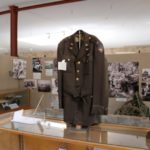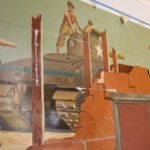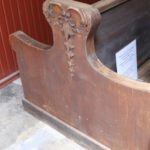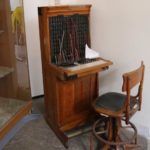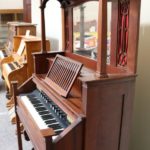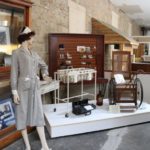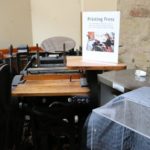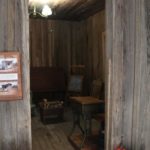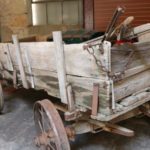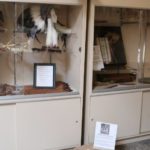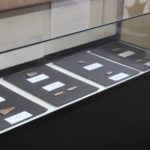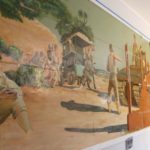The Brown County Museum of History has opted to turn a negative into a positive. Closed since March due to the COVID-19 pandemic, the museum is in the process of “freshening up” its exhibits before reopening in the fall.
“We’re taking advantage of the time and making the most of it so when we do open up it’s going to be really amazing,” said Brown County Museum of History President Beverly Norris. “As time drug on we thought we’re gonna really dig in and when we open it’s going to be amazingly changed. We’re pushing forward all the things we had planned into this time period. Every exhibit is going to be retouched. We’ve either moved it, or added to it, or revitalized it.”
Among the prize pieces literally receiving a fresh coat of paint during the down time is the World War II mural.
“One of our biggest stories is the restoration of the World War II mural,” Norris said. “This was painted during World War II by German POWs celebrating the victory of the American troops. It was in the non-commissioned officers building out at Camp Bowie, which was known more recently as the Senior Citizens Center.”
Norris described the process of the discovery of the painting and its move to the museum, located at 209 N. Broadway.
“It was in that building and at one point got totally covered over,” Norris said. “They were doing renovations and uncovered it, it was behind the paneling and discovered, but it languished out there. The City knew no one could really see it out there and it was about a four or five year process to get that here. We had to prepare the walls and get it physically moved, of course it was so fragile because it was painted directly on 1940s era drywall. They literally took it off the studs. You can see at the top the more damaged parts and the way it looked. It was put back up and now we have an artist who is restoring it and bringing it back to life. We found old photos that showed more of what it looked like. It had big pieces cut out for a doorway and one area had been a serving window, so she’s filling that space and restoring it.”
Among the new additions is a propeller from a plane that crashed in Lake Brownwood during the Camp Bowie era.
“For a long time this airplane propeller had been in the portico of the jail but it didn’t belong over there, it needed to be here with the Camp Bowie exhibit,” Norris said. “During World War II I don’t know if a lot of people know there were flight schools and flight training done at Camp Bowie and this plane crashed into Lake Brownwood. One of the pilots was killed, the other was court martialed. It was under water until a big drought in the 1980s then it was discovered and taken out. It’s been here but now we’re able to place it and display it and have people see it.
“It’s tremendously heavy, it took three men everything they had to move it. We’re just going to leave it here, this was the way it was retrieved from the lake bottom.”
Norris stated the entire Camp Bowie exhibit will receive a touch up.
“We are reorienting everything within the Camp Bowie exhibit,” Norris said. “It’s on a timeline that begins in 1939 before the war started. I think it helps people to understand how the war happened, and then the history of Camp Bowie, how it was built and its role when the war starts.”
Norris said almost every item in the museum has moved aside from the log cabin and one-room schoolhouse, While the school remains in the same spot, there will be additions to the exhibit.
“We’re going to have an exhibit about the Griffin Schoolhouse, the one-room Black school,” Norris said. “We’ve got some amazing photographs and we’re going to really broaden the scope a little bit and talk more about rural education in general. We’re so pleased to be able to preserve that.”
Norris touched on a few more new additions coming to the museum:
* Printing Press
“The printing press is going to have an exciting new life,” Norris said. “We’ve always had it but an artist from North Carolina is going to come down. These small printing presses have gotten very popular with artists as a way to print off their art work. She’s going to come and we’ll have a special event where people can carve their own block and it will be reproduced so they will get to learn about the press and also produce their own little piece of artwork. There will different times where people can print and learn about the type and see it happen. That’s going to be a great new addition that will become a living exhibit.”
* The Devil’s Wire – Barbwire Exhibit
“We have a volunteer who is working to lay out the barbwire exhibit and the role that played with the west,” Norris said. “Brown County was a pivotal place, there was more deaths and bloodshed in Brown County over the fence cutting wars than any other county in Texas. The governor of Texas had to call out the Texas Rangers to come here to Brown County, people were storming the courthouse, murders, and property damage, millions of dollars worth in the 1800s. It was a wild and woolly place.”
* The Land We Love – Ranching in Brown County
“We’ve recently gotten a generous donation that will make the exhibit happen,” Norris said. “We’re going to talk about the past and present and the conservation efforts that need to be done now. We’ll talk about how grazing was used in the 1800s and moving forward we want people to think about grass and water conservation in the future.”
* Boot and Saddle Shop
“There was a boot shop in Brownwood called the Melwood Boot Shop,” Norris said. “All the components used to be the Grace Museum in Abilene and they gifted it back to Brownwood, they were excited to return it home. The boot and saddle shop will be in here, I’d say it’s about half done. Actual pieces of equipment will be put back when the painting is done. They’ll be a chance for kids to do a little leather work.”
* Tylene Wilson
“She was the subject of the recent book ‘When The Men Were Gone,’” Norris said. “They’ll be an exhibit for her and we have some really cool football stuff in the back right now – helmets, cleats, shoulder pads, etc.”
* Buffalo and Native Americans
“We’ll have an exhibit on the buffalo, it played such an important role in the Native Americans’ lives and demise,” Norris said. “The white men knew that and that was one reason they destroyed the buffalo, to be able to control the Native Americans.”
* Talk of the Town – Telephones + Radios and Music
“Just the basics are here now, we’ve moved the organs and pianos and we’ve gotten way back in our archives and brought out the old radios,” Norris said. “You will be able to play music from different eras of each particular radio. The little kids are amazed. There is an amazing telephone booth on loan to us for now and the switchboard, the kids love.”
* Business in Brown County
“Our business and office machines will be here,” Norris said. “We’ll also have a photo display showing the growth of business in Brownwood and how it grew and changed. We have a lot of old typewriters to bring out, they’ve gotten kind of popular again, too.”
The museum has also added “the weeping bench,” which sat in the lobby of Brownwood’s First National Bank where customers waited to talk to their banker.
The circus exhibit has been relocated within the building, while the Molly Armstrong exhibit has expanded to include medical aspects.
The exhibits aren’t the only parts of the 8,000 square foot building receiving an upgrade.
“One of the biggest things we’re going to do, starting possibly this week, is the entire ceiling will be repaired and painted so we’ve not put out everything yet,” Norris said. “When we get the painting done we’ll be doing some carpeting throughout, so we’re really hoping to freshen up the interior. There’s such an amazing collection here, we really want the building to represent the value of what’s here.”
Norris has set a target date of when the museum hopes to reopen, but that could change.
“We’re shooting for Oct. 1 but with coronavirus we’ve had so many dates we’ve had to push back. I feel like we will be able to open in the fall,” Norris said. “We’ll probably be slower with opening than other types of venues because everything in here is touchable, they can experience by touching. It makes it a little harder for us to be corona proof.”
As for the history and items, both old and new, within the museum, Norris said, “There’s so many things about Brown County that I, like everybody when you grow up somewhere or if you move here, didn’t know what happened. But there are some pretty remarkable things that have happened here.”
For more information on the Brown County Museum of History visit its Facebook page or official website at browncountymuseum.org.

